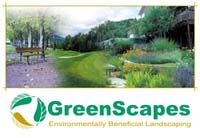Benefits of GreenScaping
Note: EPA no longer updates this information, but it may be useful as a reference or resource.

Cost Savings | Waste Reduction | Water Conservation | Environmental Impact | Energy Savings | Climate Impact | Additional Benefits
Cost Savings
Following the principles of GreenScapes can be a great financial move for your organization. Green landscaping means buying fewer products and switching from the purchase of disposable ones to those that are long-lasting and reusable. Use our online calculators to see how much you can save by comparing costs between environmentally preferable methods and using virgin materials. Buying durable goods might be more expensive at the time of purchase, but over the life of your landscape, maintenance, repurchasing, and tipping costs will go down. These savings can give your business an edge over the competition!
There are also immediate cost savings you can recognize. By composting instead of disposing of your yard waste, for instance, you will save money on disposal costs. Compost adds disease-suppressing properties to soils, reducing your need for pesticides. Even a move as small as leaving grass clippings on your lawn after mowing can save big bucks—lowered disposal costs and, because decomposing grass pieces return valuable nutrients to the soil, lowered fertilizer costs.
Waste Reduction
Millions of tons of waste materials are hauled away, buried, or burned each day from landscaping and grounds keeping operations—trees, shrubs, brush, lumber, asphalt, and concrete, to name only a few. Millions of gallons of excess water, pesticides, fuels, and oils are in use each and every day. Why pay to dispose of this waste when you can avoid it? Following the GreenScapes philosophies of reduce, reuse, recycle, and rebuy can lower your tipping fees and other costs related to disposal.
All of this waste also impacts our environment. By reducing your landscape’s consumption, you will be helping prevent greenhouse gases (GHGs), save landfill space, and preserve natural resources.
Water Conservation
Most large-scale landscapes use an incredible amount of water to keep plants green and healthy. There are various GreenScapes activities you can try to reduce your water use and keep your plants beautiful. Just maintaining an efficient irrigation system and adjusting the time of day that you water can save money.
A longer-term adjustment can be made by bringing native plants to your landscapes. Vegetation that is native to your area will be naturally hardier and more tolerant to your weather conditions. Planting native vegetation will reward you with lower water, fertilizer, and pesticide bills.
There are also GreenScapes methods to reduce runoff of storm water and irrigation water that carry top soils, fertilizers, and pesticides into local rivers and lakes. Drawing from storm retention ponds supplies irrigation applications, as does installing rain barrels or cisterns to catch free rain water on and around buildings. These options save water and money while reducing runoff, erosion, and non-point source pollution.
Environmental Impact
The huge amounts of waste generated, water used, and energy consumed to maintain a large landscape have an incredible impact on our environment. Every piece of trash takes up room in a landfill, and produces greenhouse gases not only as it decomposes, but during each step of its production and transportation. Energy is required to treat and transport water—energy that generally comes from nonrenewable, polluting sources. And toxic pesticides and fertilizers abound in a typical large landscape, leading to the pollution of local rivers and lakes. Landscaping by the philosophies of GreenScapes will help you to minimize or avoid these environmental issues, lessening your landscape’s impact on the earth.
Energy Savings
Almost every material that you use on your landscape required energy to reach you. Large amounts of energy are used in acquiring materials, manufacturing products, and shipping products to you. Energy is used to produce and ship soil additives, water, tools, machines, paints, and virtually every other material used in landscaping. By purchasing fewer, more durable goods, you are saving an untold amount of energy.
Many green landscaping activities help reduce energy usage. Creating compost on site not only reduces the energy needed to transport organic waste to a landfill, but it eliminates the need for the production and transportation of fertilizers and often pesticides. Compost also absorbs water, reducing the amount of irrigation necessary and the energy required to transport the water. Strategic planting of vegetation around buildings can reduce indoor heating and cooling needs by creating shade.
Climate Impact
Most materials used on landscapes have an impact on our climate. Every product you use emitted GHGs as it was manufactured and transported, and will continue to produce GHGs in a landfill as it decomposes. The constant buying and trashing of products regularly adds GHGs to our atmosphere and impacts the climate. See Climate Change and Waste for more information.
Additional Benefits
- Reduced exposure of your customers, employees, and yourself to potentially harmful chemicals, solvents, fuels, and pesticides.
- Increased beauty: a natural environment is aesthetically pleasing.
- Improved public perception of your business.
- Knowledge that you are making a difference by helping prevent pollution, curb climate change, and reduce your “environmental footprint” on the earth.
![[logo] US EPA](../gif/logo_epaseal.gif)